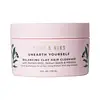What's inside
What's inside
 Key Ingredients
Key Ingredients

 Benefits
Benefits

 Concerns
Concerns

 Ingredients Side-by-side
Ingredients Side-by-side

Glycerin
HumectantSodium Cocoyl Isethionate
CleansingKaolin
AbrasiveCoconut Acid
CleansingVaccinium Corymbosum Seed
AbrasiveCetearyl Alcohol
EmollientPolylactic Acid
AbrasiveSodium Isethionate
CleansingCocos Nucifera Oil
MaskingBentonite
AbsorbentBehentrimonium Methosulfate
Tapioca Starch
Moringa Oleifera Seed Oil
EmollientSimmondsia Chinensis Seed Oil
EmollientArnica Montana Flower Extract
MaskingEclipta Prostrata Leaf Extract
Skin ConditioningHibiscus Esculentus Fruit Extract
Skin ConditioningPhyllanthus Emblica Fruit Extract
HumectantParfum
MaskingPhenoxyethanol
PreservativeCaprylyl Glycol
EmollientGlycerin, Sodium Cocoyl Isethionate, Kaolin, Coconut Acid, Vaccinium Corymbosum Seed, Cetearyl Alcohol, Polylactic Acid, Sodium Isethionate, Cocos Nucifera Oil, Bentonite, Behentrimonium Methosulfate, Tapioca Starch, Moringa Oleifera Seed Oil, Simmondsia Chinensis Seed Oil, Arnica Montana Flower Extract, Eclipta Prostrata Leaf Extract, Hibiscus Esculentus Fruit Extract, Phyllanthus Emblica Fruit Extract, Parfum, Phenoxyethanol, Caprylyl Glycol
Water
Skin ConditioningSodium Laureth Sulfate
CleansingGlycerin
HumectantKaolin
AbrasiveCocamidopropyl Betaine
CleansingMontmorillonite
AbsorbentSodium Citrate
BufferingHexylene Glycol
EmulsifyingCitric Acid
BufferingAcrylates Copolymer
Sodium Chloride
MaskingSodium Hydroxide
BufferingSodium Benzoate
MaskingCaprylyl Glycol
EmollientHydroxypropyl Guar Hydroxypropyltrimonium Chloride
Menthol
MaskingPolyquaternium-10
Salicylic Acid
MaskingLinalool
PerfumingCapryloyl Glycine
CleansingLimonene
PerfumingGeraniol
PerfumingCitronellol
PerfumingAlpha-Isomethyl Ionone
PerfumingCharcoal Powder
AbrasiveCI 19140
Cosmetic ColorantCI 42090
Cosmetic ColorantPolyglycerin-10
HumectantPolyglyceryl-10 Myristate
Skin ConditioningPolyglyceryl-10 Stearate
Skin ConditioningSodium Dehydroacetate
PreservativeParfum
MaskingWater, Sodium Laureth Sulfate, Glycerin, Kaolin, Cocamidopropyl Betaine, Montmorillonite, Sodium Citrate, Hexylene Glycol, Citric Acid, Acrylates Copolymer, Sodium Chloride, Sodium Hydroxide, Sodium Benzoate, Caprylyl Glycol, Hydroxypropyl Guar Hydroxypropyltrimonium Chloride, Menthol, Polyquaternium-10, Salicylic Acid, Linalool, Capryloyl Glycine, Limonene, Geraniol, Citronellol, Alpha-Isomethyl Ionone, Charcoal Powder, CI 19140, CI 42090, Polyglycerin-10, Polyglyceryl-10 Myristate, Polyglyceryl-10 Stearate, Sodium Dehydroacetate, Parfum
Ingredients Explained
These ingredients are found in both products.
Ingredients higher up in an ingredient list are typically present in a larger amount.
Caprylyl Glycol is a humectant and emollient, meaning it attracts and preserves moisture.
It is a common ingredient in many products, especially those designed to hydrate skin. The primary benefits are retaining moisture, skin softening, and promoting a healthy skin barrier.
Though Caprylyl Glycol is an alcohol derived from fatty acids, it is not the kind that can dry out skin.
This ingredient is also used as a preservative to extend the life of products. It has slight antimicrobial properties.
Learn more about Caprylyl GlycolGlycerin is already naturally found in your skin. It helps moisturize and protect your skin.
A study from 2016 found glycerin to be more effective as a humectant than AHAs and hyaluronic acid.
As a humectant, it helps the skin stay hydrated by pulling moisture to your skin. The low molecular weight of glycerin allows it to pull moisture into the deeper layers of your skin.
Hydrated skin improves your skin barrier; Your skin barrier helps protect against irritants and bacteria.
Glycerin has also been found to have antimicrobial and antiviral properties. Due to these properties, glycerin is often used in wound and burn treatments.
In cosmetics, glycerin is usually derived from plants such as soybean or palm. However, it can also be sourced from animals, such as tallow or animal fat.
This ingredient is organic, colorless, odorless, and non-toxic.
Glycerin is the name for this ingredient in American English. British English uses Glycerol/Glycerine.
Learn more about GlycerinKaolin is a clay. It is used for oil control and to help minimize pores. Like other clays, kaolin has the ability to absorb excess sebum or oil. This can help clean out pores and mattify the skin.
Some types of kaolin may have exfoliating properties. When water is added to kaolin, it becomes a paste with small abrasive particles.
Most kaolin is a white color, but may be pink/orange/red depending on where it comes from.
The name 'kaolin' comes from a Chinese village named 'Gaoling'. Kaolin clay comes from rocks rich in kaolinite. Kaolinite, the mineral, has a silicate layered structure. Kaolinite is formed from chemical weathering of aluminum siilicate minerals.
Besides skincare, kaolin is commonly used to make glossy paper, in ceramics, toothpaste, and as medicine to soothe stomach issues.
Learn more about KaolinParfum is a catch-all term for an ingredient or more that is used to give a scent to products.
Also called "fragrance", this ingredient can be a blend of hundreds of chemicals or plant oils. This means every product with "fragrance" or "parfum" in the ingredients list is a different mixture.
For instance, Habanolide is a proprietary trade name for a specific aroma chemical. When used as a fragrance ingredient in cosmetics, most aroma chemicals fall under the broad labeling category of “FRAGRANCE” or “PARFUM” according to EU and US regulations.
The term 'parfum' or 'fragrance' is not regulated in many countries. In many cases, it is up to the brand to define this term.
For instance, many brands choose to label themselves as "fragrance-free" because they are not using synthetic fragrances. However, their products may still contain ingredients such as essential oils that are considered a fragrance by INCI standards.
One example is Calendula flower extract. Calendula is an essential oil that still imparts a scent or 'fragrance'.
Depending on the blend, the ingredients in the mixture can cause allergies and sensitivities on the skin. Some ingredients that are known EU allergens include linalool and citronellol.
Parfum can also be used to mask or cover an unpleasant scent.
The bottom line is: not all fragrances/parfum/ingredients are created equally. If you are worried about fragrances, we recommend taking a closer look at an ingredient. And of course, we always recommend speaking with a professional.
Learn more about Parfum